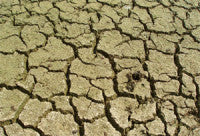Sunken Trench Lines could cause problems
Sunken Trench Lines could cause problems
By Bruce N Brockway

As the drought continues the LDCA alerts Sports Operators to the risks of settlement of trench lines due to soil shrinkage.
Because of the dry conditions in some areas so far this year the LDCA is warning that if 2006 proves to be as dry as 2003, settlement of drainage trench lines on sports and amenity turf could be particularly severe. Operators of sports facilities should be aware that the problem could recur this year especially on clay soil sites.
This can affect new drainage installations and possibly existing ones in severe drought conditions. Those having drainage installed should ensure that remedial measures to cater for possible trench settlement are agreed with the drainage contractor in advance. Those with an existing drainage scheme should seek advice on how best to minimise the problem if it occurs.
The summer of 2003 was recorded as one of the driest periods for many decades. The exceptional weather resulted in a phenomenon associated with soils of high plasticity and expansion related to moisture content. Shrinkage of such soils - due to soil and ground moisture deficit - resulted in subsidence of buildings, cracking of roads, and in respect of trenching, settlement of trench lines.
Settlement or cracking within trench lines in agricultural environments is not generally a problem and, indeed, is considered beneficial to the restructuring of consolidated or compacted soils. However, the leisure and amenity sector has suffered to varying degrees, in some extreme cases sports turf facilities have been rendered no longer fit for use due to the hazard caused by cracking or settled trench lines.
A sports turf facility equipped with a drainage scheme will typically have a network of mains and lateral pipe work spaced at between 3 and 10 metre centres. The pipes are installed within excavated trenches and are backfilled with aggregate. Tri-axial shrinkage of the clay soils leads to increased trench widths allowing the backfill materials to settle causing depressions on the surface.

The clay soils of the British Isles retain soil moisture with great tenacity. Water will only be drained from a soil once field capacity has been achieved; the drainage scheme will remove surplus soil water.
The dry summer / autumn of 2003 resulted in the lowest recorded annual rainfall in the UK since 1964 according to the Meteorological Office data. This allowed the drying of soil profiles to unprecedented depths with very low soil moisture content at depths exceeding 600mm.
The resultant soil shrinkage and cracking generated settlement of trench and slit lines on both newly installed and, more surprisingly, existing established schemes which have been installed for a number of years.
Once settlement has occurred, remediation measures are limited to topping up. On intensive schemes, general sand or root zone top dressing may be an option but deep settlement will require specific application to individual trench lines by means of specialist equipment.
Information on sportsturf drainage and a list of contractors is available from the Land Drainage Contractors Association website www.ldca.org or Tel: 01327 263264
